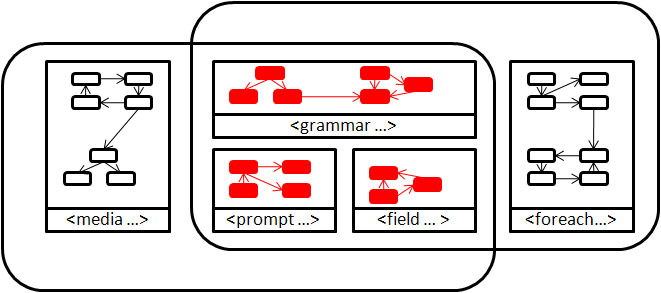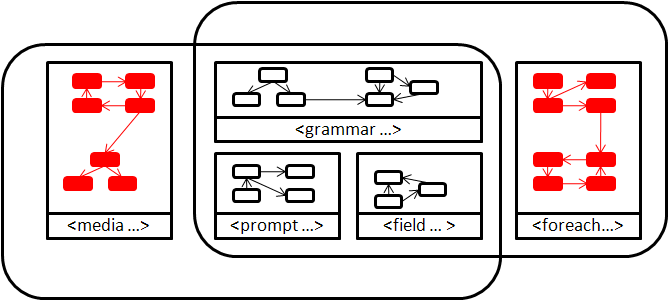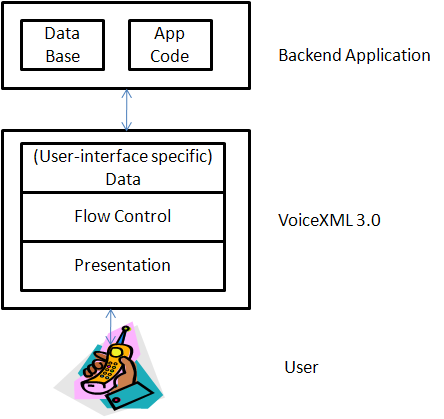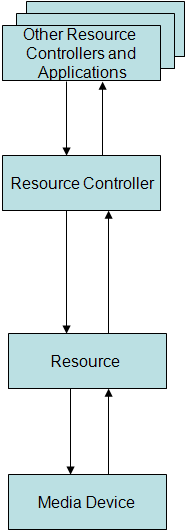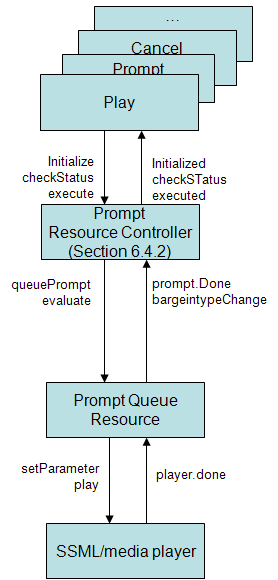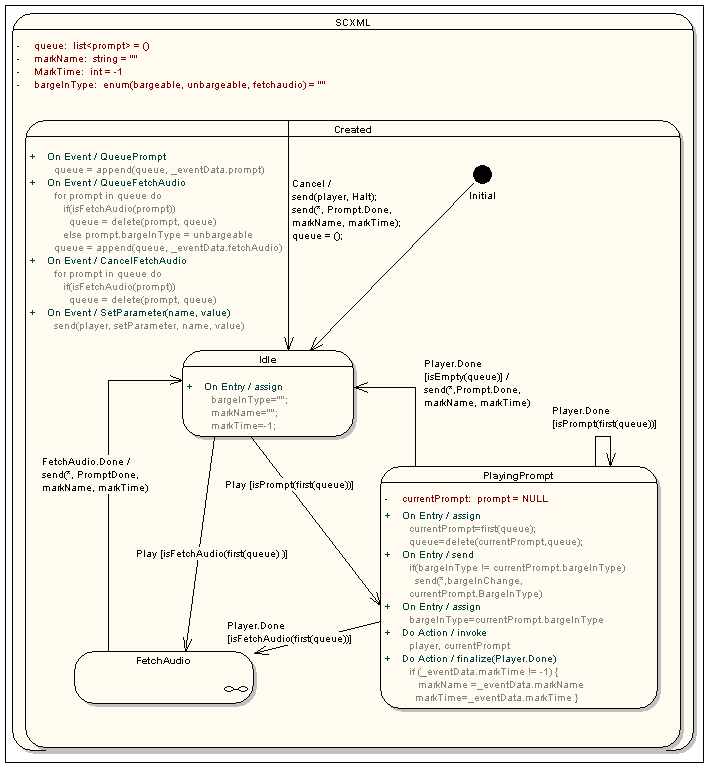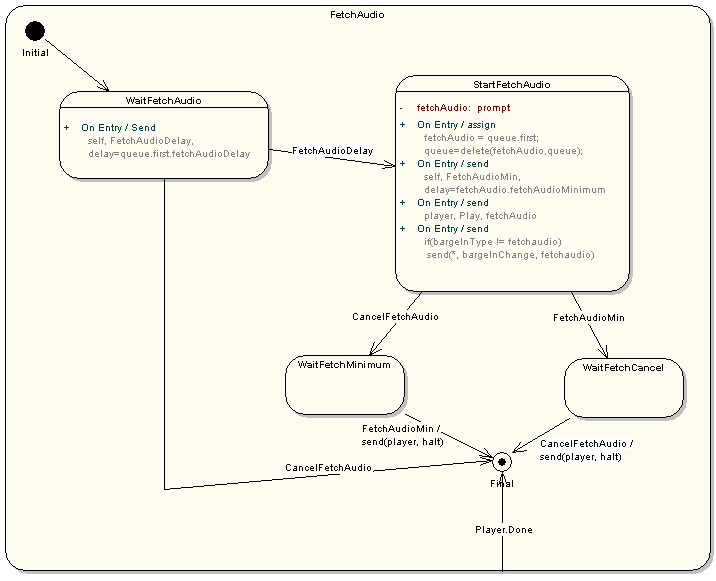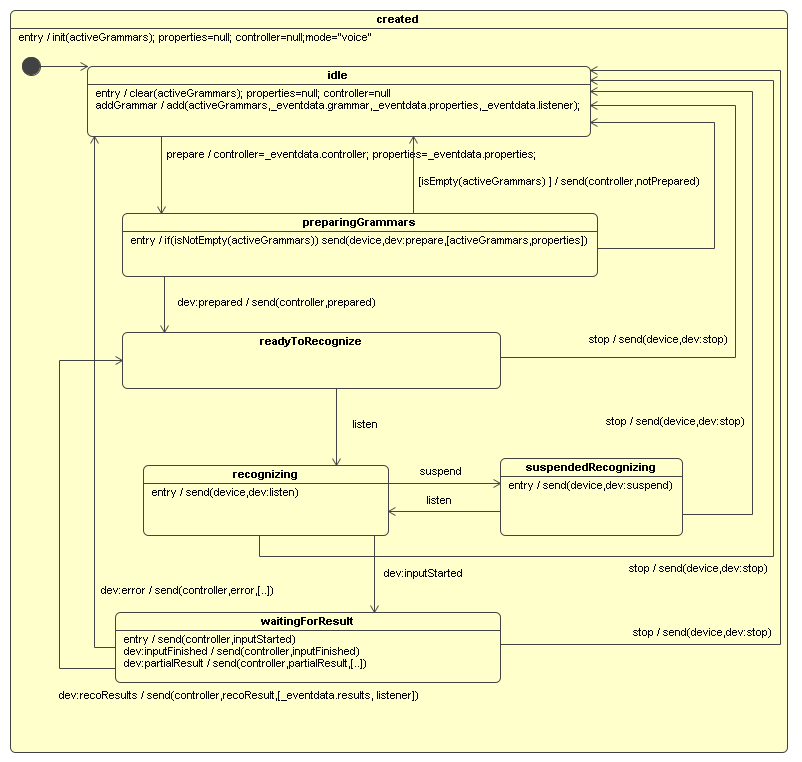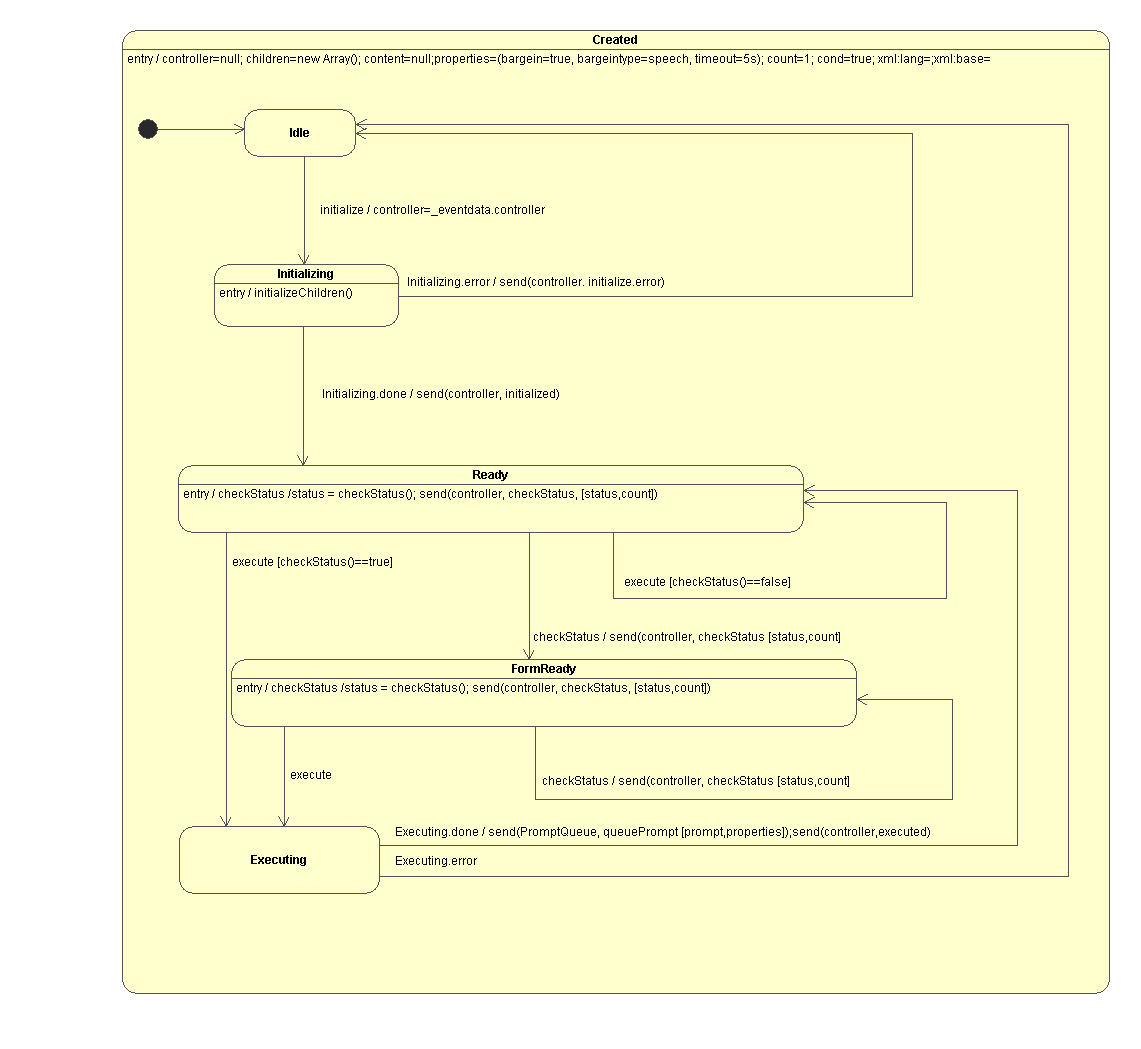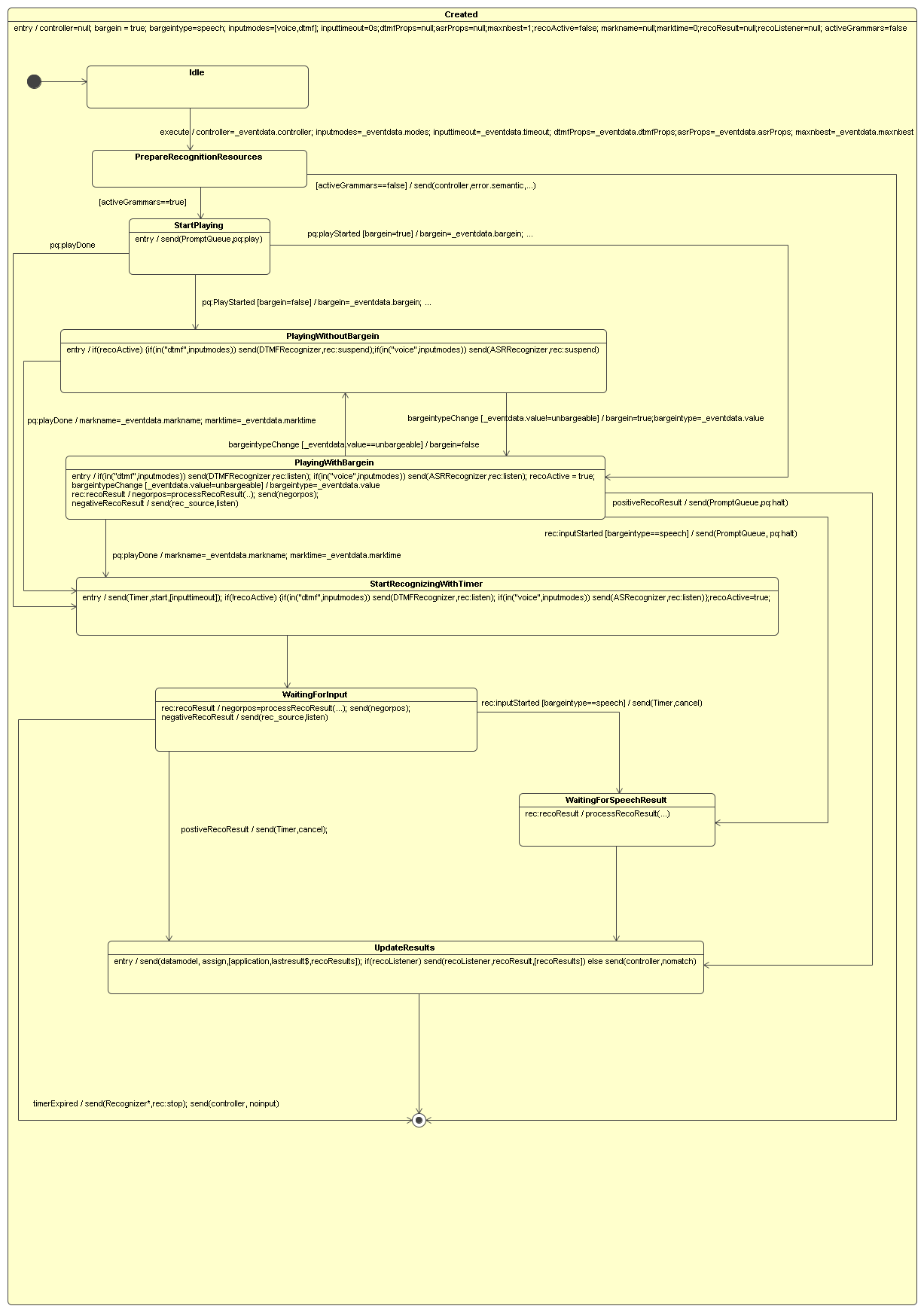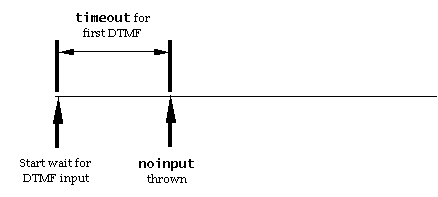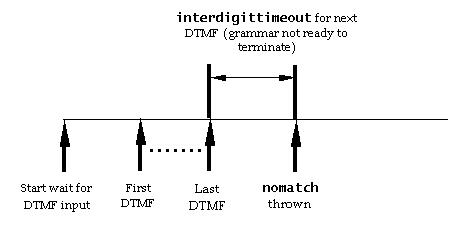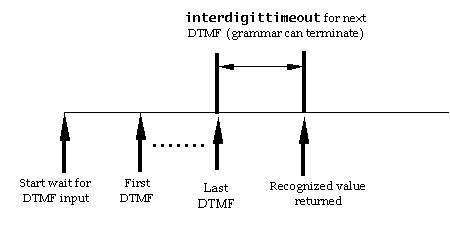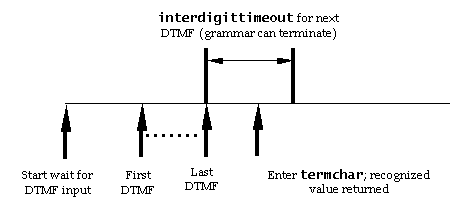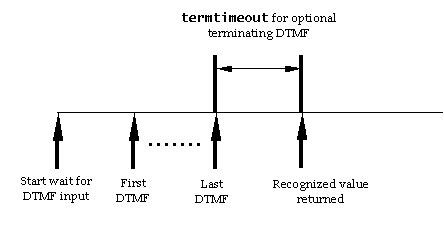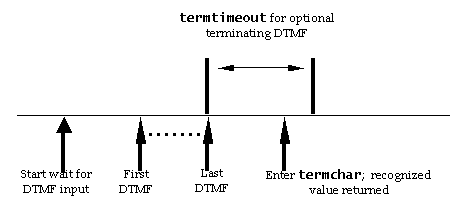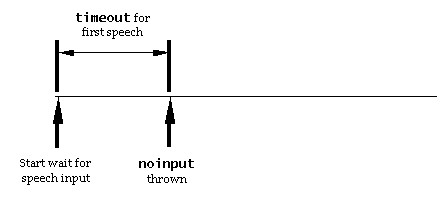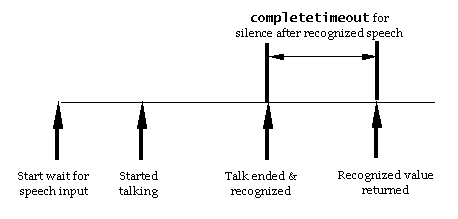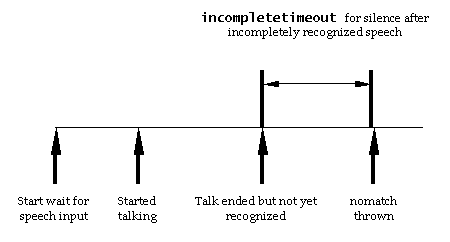The
PlayandRecognize
RC
coordinates
media
input
with
Recognizer
resources
and
media
output
with
the
PromptQueue
Resource.
6.10.2.2.1
Definition
The
PlayandRecognize
RC
coordinates
media
input
with
recognition
resources
and
media
output
with
the
PromptQueue
Resource
on
behalf
of
a
form
item.
This
RC
activates
prompt
queue
playback,
activates
recognition
resources,
manages
bargein
behavior
and
handles
results
from
recognition
resources.
The
RC
is
defined
in
terms
of
a
data
model
and
a
state
model.
The
data
model
is
composed
of
the
following
parameters:
-
controller:
the
RC
controlling
this
RC
-
bargein:
Boolean
indicates
whether
bargein
is
active
or
not.
Default:
true.
-
bargeintype:
indicates
the
type
of
bargein,
if
active.
Default:
speech.
-
inputmodes:
active
recognition
input
modes.
Default:
voice
and
dtmf.
-
inputtimeout:
timeout
to
wait
for
input.
Default:
0s.
(Required
since
the
prompt
queue
may
be
empty).
-
dtmfProps:
DTMF
properties
-
asrProps:
Speech
recognition
properties
-
maxnbest:
maximum
number
of
nbest
results.
Default:
1.
-
recoActive:
boolean
indicating
whether
recognition
is
active.
Default:
false.
-
markname:
string
indicating
current
markname.
Default:
null
-
marktime:
time
designator
indicating
current
marktime.
Default:
0s.
-
recoResult:
-
recoListener:
-
activeGrammars:
Boolean
indicating
whether
grammars
are
active.
Default:
false.
The
RC
model
consists
of
the
following
states:
idle,
prepare
recognition
resources,
start
playing,
playing
prompts
with
bargein,
playing
prompts
without
bargein,
recognizing
with
a
timer,
waiting
for
input,
waiting
for
speech
result
and
update
results.
The
complexity
of
this
model
is
partially
a
consequence
of
supporting
the
relationship
between
hotword
bargein
and
recognition
result
processing.
While
in
the
idle
state,
the
RC
may
receive
an
'execute'
event,
whose
event
data
is
used
to
update
the
data
model.
The
event
information
includes:
controller,
inputmodes,
inputtimeout,
dtmfProps,
asrProps
and
maxnbest.
The
RC
transition
to
the
prepare
recognition
resources
state.
In
the
prepare
recognition
resources,
the
RC
sends
'prepare'
events
to
the
ASR
and
DTMF
recognition
resource.
Both
events
specify
this
RC
as
the
controller
parameter,
while
the
properties
parameter
differs.
In
this
state,
the
RC
can
received
'prepared'
or
'notPrepared'
events
from
either
recognition
resources.
If
neither
resource
returns
a
'prepared'
event,
then
activeGrammars
is
false
(i.e.
no
active
DTMF
or
speech
grammar)
and
the
RC
sends
an
'error.semantic'
event
to
the
controller
and
exits.
If
at
least
one
resource
returns
a
'prepared'
event,
then
the
RC
moves
into
the
start
playing
state.
The
start
playing
state
begins
by
sending
the
PromptQueue
resource
a
'play'
event.
The
PromptQueue
responds
with
a
'playDone'
event
if
there
are
no
prompt
in
the
prompt
queue;
as
a
result,
this
RC
moves
into
the
start
recognizing
with
timer
state.
If
there
is
at
least
one
prompts
in
the
queue,
the
PromptQueue
sends
this
RC
a
'playStarted'
event
whose
data
contains
the
bargein
and
bargeintype
values
for
the
first
prompt,
and
the
input
timeout
value
for
the
last
prompt
in
the
queue.
The
data
model
is
updated
with
this
information.
|
Editorial
note
|
|
|
Open
issue:
PromptQueue
Resource
doesn't
currently
have
playStarted
event.
If
we
don't
add
playStarted
event,
then
is
there
a
better
way
to
get
the
bargein,
bargeintype,
and
timeout
information
from
the
prompts
in
the
PromptQueue?
|
Interaction
with
the
recognizer
during
prompt
playback
is
determined
by
the
data
model's
bargein
value.
If
bargein
is
true,
then
this
RC
transitions
to
the
playing
with
bargein
state.
If
bargein
is
false,
the
RC
transitions
to
the
playing
without
bargein
state.
|
Editorial
note
|
|
|
Open
Issue:
The
event
"bargeinChange"
as
a
one
way
notification
could
pose
a
problem,
as
it
takes
finite
time
for
recognizer
to
suspend
or
resume.
This
might
work
better
if
PromptQueue
Resource
waited
for
an
event
"bargeinChangeAck"
(or
similar)
from
PlayandRecognize
RC
before
starting
the
next
play.
PlayandRecognize
RC
will
send
the
event
"bargeinChangeAck"
after
it
completed
suspend
or
resume
action
on
the
recognizer.
|
In
the
playing
without
bargein
state,
recognition
is
suspended
if
it
has
been
previously
activated
(recoActive
parameter
of
the
data
model
tracks
this).
Suspending
recognition
is
conditional
on
the
value
of
'inputmodes'
data
parameter;
if
'dtmf'
is
in
inputmodes,
then
DTMF
recognition
is
suspended;
if
'voice'
is
in
inputmodes,
the
ASR
recognition
is
suspended.
In
this
state,
the
PromptQueue
can
report
to
this
RC
changes
in
bargein
and
bargeintype
as
prompts
are
played:
a
'bargeintypeChange'
event
with
the
values
'hotword'
or
'speech'
cause
the
data
model
parameter
'bargein'
to
the
set
to
'true'
and
the
'bargintype'
'bargeintype'
parameter
to
be
updated
with
event
data
value.
If
the
PromptQueue
resource
sends
a
'playDone'
event,
then
the
data
model
markname
and
marktime
parameters
are
updated
and
the
RC
transitions
to
the
start
recognizing
with
timer
state.
In
the
playing
with
bargein
state,
recognition
is
activated
if
it
has
not
been
previously
activated
(determined
by
recoActive
parameter
in
the
data
model).
Activating
recognition
is
conditional
on
the
value
of
'inputmodes'
data
parameter;
if
'dtmf'
is
in
inputmodes,
then
DTMF
recognition
is
activated;
if
'voice'
is
in
inputmodes,
then
ASR
recognition
is
activated.
In
this
state,
the
PromptQueue
can
report
changes
in
bargein
and
bargeintype
as
prompts
are
played:
a
'bargeintypeChange'
event
where
the
event
data
value
is
not
'unbargeable'
causes
the
data
model
'bargintype'
'bargeintype'
parameter
to
be
updated
with
the
event
data
('hotword'
or
'speech');
while
a
'bargeintypeChange'
where
the
event
data
value
is
'unbargeable'
causes
the
data
model
'bargein'
parameter
to
set
to
false
and
the
RC
transitions
to
the
playing
without
bargein
state.
If
the
PromptQueue
resources
sends
a
'playDone'
event,
then
the
data
model
markname
and
marktime
parameters
are
updated
and
the
RC
transitions
to
the
start
recognizing
with
timer
state.
Recognition
handling
in
this
state
depends
upon
the
bargeintype
data
parameter.
If
the
bargeintype
is
'speech'
and
a
recognizer
sends
a
'inputStarted'
event,
then
the
RC
transition
to
the
waiting
for
speech
result
state.
If
the
bargeintype
is
'hotword',
then
recognition
results
are
processed
within
this
state.
In
particular,
if
a
recognition
resource
sends
a
'recoResults'
event,
then
its
event
data
is
processed
to
determine
if
the
recognition
result
is
positive
or
negative.
|
Editorial
note
|
|
|
Further
details
on
recognition
processing
to
be
added
in
later
versions.
recoResults
data
parameter
is
updated
with
the
recognition
results
(truncated
to
maxnbest).
A
speech
result
is
positive
iff
there
is
at
least
one
result
whose
confidence
level
is
equal
to
or
greater
than
the
recognition
confidence
level;
otherwise
the
result
is
negative.
DTMF
results
are
always
positive.
The
recoListener
data
parameter
is
defined
as
the
listener
associated
with
the
best
result
if
the
result
is
positive.
|
If
positive,
the
RC
sends
the
PromptQueue
a
'halt'
event,
and
transitions
to
the
update
results
state.
If
negative,
the
RC
sends
a
'listen'
event
to
the
recognition
resource
which
sent
the
'recoResults'
event.
In
the
start
recognizing
with
timer
state,
an
input
timer
is
activated
for
the
value
of
the
inputtimeout
data
parameter
and,
if
the
recognition
is
not
already
active
(determined
by
the
recoActive
data
parameter).
Recognition
activation
is
conditional
on
the
value
of
'inputmodes'
data
parameter;
if
'dtmf'
is
in
inputmodes,
then
DTMF
recognition
is
activated;
if
'voice'
is
in
inputmodes,
the
ASR
recognition
is
activated.
The
RC
then
transitions
into
the
waiting
for
input
state.
In
the
waiting
for
input
state,
the
RC
waits
for
user
input.
If
it
receives
a
'timerExpired'
event,
then
the
RC
sends
a
'stop'
event
to
all
recognition
resources,
sends
a
'noinput'
event
to
its
controller
and
exits.
Recognition
handling
in
this
state
depends
upon
the
bargeintype
data
parameter.
If
the
bargeintype
is
'speech'
and
a
recognizer
sends
a
'inputStarted'
event,
then
the
RC
transition
to
the
waiting
for
speech
result
state.
If
the
bargeintype
is
'hotword',
then
recognition
results
are
processed
within
this
state.
In
particular,
if
a
recognition
resource
sends
a
'recoResults'
event,
then
its
event
data
is
processed
to
determine
if
the
recognition
result
is
positive
or
negative.
If
positive,
the
RC
cancels
the
timer,
and
transitions
to
the
update
results
state.
If
negative,
the
RC
sends
a
'listen'
event
to
the
recognition
resource
which
sent
the
'recoResults'
event.
In
the
waiting
for
speech
result
state,
the
RC
waits
for
a
'recoResult'
event
whose
data
is
used
to
update
the
recoResult
data
parameter
and
to
set
the
recoListener
data
parameter
if
the
recognition
result
is
positive.
The
RC
then
transitions
to
the
update
results
state.
In
the
update
results
state,
the
RC
sends
'assign'
events
to
the
data
model
resource,
so
that
the
lastresult
object
in
application
scope
is
updated
with
recognition
results
as
well
as
markname
and
marktime
information.
If
the
recoListener
data
parameter
is
defined,
then
the
RC
sends
a
'recoResult'
event
to
the
recognition
listener
RC;
otherwise,
it
sends
'nomatch'
event
to
its
controller.
The
RC
then
exits.
|
Editorial
note
|
|
|
Open
issue:
Behavior
if
one
reco
resource
sends
'inputStarted'
but
other
sends
'recoResults'?
Race
conditions
between
recognizers
returning
results?
(This
problem
is
inherent
to
the
presence
of
two
recognizers.
For
the
sake
of
clear
semantics,
we
could
restrict
only
one
recognizer
to
respond
with
'inputStarted'
and
'recoResults'.
The
other
recognizer
is
always
'stopped'.
But
a
better
choice
might
be
to
have
only
one
recognizer
that
handles
both
DTMF
and
speech,
since
semantically
both
recognizers
are
very
similar.)
|
